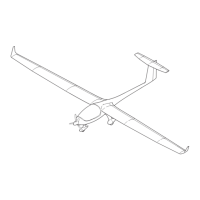
Do you have a question about the STEMME S6 and is the answer not in the manual?
| Manufacturer | Stemme AG |
|---|---|
| Height | 1.7 m (5 ft 7 in) |
| Gross weight | 850 kg (1, 874 lb) |
| Category | Glider |
| Type | Motor glider |
| Crew | 1 |
| Capacity | One passenger |
| Fuel Capacity | 100 L (26 US gal; 22 imp gal) |
Overview of the Flight Manual's purpose for the STEMME S6.
Details on the motorglider's certification basis and approval.
Explanation of terms used for safety and important remarks.
Technical data and dimensions of the aircraft and its components.
Illustrative drawing of the aircraft with key dimensions.
Definitions of technical terms and abbreviations used in the manual.
Table of imperial and metric units and their conversion factors.
List of referenced documents and manufacturers for aircraft components.
Overview of operating limitations, instrument markings, and placards.
Defines air-speed limitations and their importance for flight.
Explanation of air-speed indicator markings and their meanings.
Details limitations for the engine, propeller, and operating fluids.
Indicates markings and ranges for engine instruments.
Details markings for instruments other than engine instruments.
Specifies maximum take-off, landing, and payload limits.
Defines the permitted in-flight CG location limits.
Outlines the maneuvers allowed according to the Utility category.
Specifies the maximum allowed load factors for permitted maneuvers.
Defines the maximum demonstrated operating altitude.
Specifies the maximum and minimum number of crew members.
Defines allowed flight operations, e.g., VFR, day-time only.
Lists the minimum required equipment for flight.
Details the types of fuel to be used and their handling.
Provides guidelines for engine lubricants and coolant.
Details additional operational limits like crosswind and electronics.
Describes placards related to operating limitations and their positions.
Overview of checklists and procedures for managing emergencies.
Lists critical airspeeds for various emergency procedures.
Instructions for jettisoning the canopy in an emergency.
Steps for bailing out of the aircraft after canopy jettison.
Guidance for recovering from a stall in powered and glider configurations.
Procedure for recovering from an unintentional spin.
Steps to recover from a spiral-dive.
Actions to take in case of engine malfunction or failure.
Emergency actions for fire in the engine compartment or electrical system.
Actions for aborted take-offs and emergencies after lift-off.
Guidelines for emergency landings on soft ground or water.
Troubleshooting for various system malfunctions.
Overview of normal operating procedures for the STEMME S6.
Lists recommended air-speeds for take-off, landing, and go-around.
Instructions for assembling and disassembling the aircraft.
Guidance on how to safely fuel the aircraft.
Procedures for performing a visual inspection before flight.
Detailed checks for exterior and interior inspection before flight.
Covers engine start, taxiing, take-off, climb, cruise, and landing.
Overview of flight performance data for the STEMME S6.
Guidance on using performance data for flight planning.
Includes airspeed corrections, altitude effects, stall speeds, and more.
Information on aircraft weight, CG, and equipment lists.
Details on determining aircraft weights and alignment during weighing.
Procedures for documenting and calculating empty mass and CG.
Steps to calculate operating mass and CG including payload and fuel.
Lists of certified and installed equipment with mass and lever data.
Overview of the motorglider's technical description and systems.
Details on fuselage, wing system, and empennage construction.
Description of ailerons, elevator, rudder, flaps, and pedals.
Description of the Schempp-Hirth style air-brakes.
Overview of control elements and their functions.
Diagram and list of instruments and indicators on the panel.
Details on the nose-gear, main-gear, and brakes.
Description of seats, safety-harness, and attachment points.
Location, capacity, and handling of the baggage compartment.
Description of the canopy, entry, and cabin ventilation.
Information on the ROTAX 914 F2 engine, propeller, and operation.
Details on fuel tank design, pumps, and measurement.
Description of power supply, ignition, circuits, and consumers.
Description of the pitot-static system and its components.
Explanation of the stall warning system and its operation.
Procedures for ground handling and servicing the motorglider.
Schedule for routine and unscheduled maintenance tasks.
Guidelines for authorized changes and repairs to the aircraft.
Procedures for taxiing, towing, parking, and transporting the aircraft.
Instructions for cleaning and maintaining the aircraft's surfaces and components.
Guidance for diagnosing and resolving common engine issues.
Information on supplemental or alternative equipment.
Catalog of approved supplements and their installation status.
